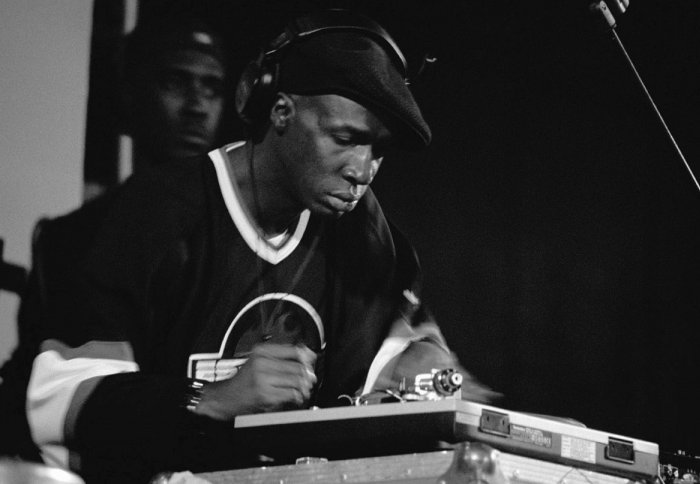
Grandmaster Flash: part of the hip-hop 'revolution'. Photo: Mika-photography/Wikimedia Commons

There have been three major revolutions in pop music, with the rise of hip-hop and rap causing the largest change in the charts, say researchers.
Computer scientists and evolutionary biologists from Imperial College London and Queen Mary University of London analysed the musical properties of 17,000 Billboard Hot 100 tunes between 1960 and 2010. They wanted to explore diversity and revolutions in pop music by tracking the range of sounds in the charts and when new musical styles came to prominence.
Their results pinpoint three major revolutions, with the rise of hip-hop in the early 1990s causing the largest pulse in new sounds. The revolution brought about by drum machines and synthesisers in the mid-1980s actually led to a drop in diversity as songs started to sound more similar, with 1986 being the least diverse year in the charts.
People often argue that music becomes ever more homogenous, but we have shown that this is not true: diversity has remained relatively constant.
– Professor Armand Leroi
Pundits have often speculated about the influence of the ‘British invasion’ in the mid-1960s on rock and roll in the US charts, but the new analysis suggests that the rock revolution began before The Beatles and The Rolling Stones crossed the ocean. The analysis suggests these bands may have exaggerated the change, but that they were riding a tide already turning, rather than creating the waves.
The researchers teamed up with music website Last.fm to mine information from the vast digital archive of popular music and add data to debates on musical history.
The research, published today in the journal Royal Society Open Science, used signal processing and text-mining to analyse the musical properties of songs. The system automatically grouped the thousands of songs by patterns of chord changes and tone, allowing researchers to statistically identify trends with an unprecedented degree of consistency.
 Evolution of musical styles in the Billboard Hot 100. The width of each spindle is proportional to the frequency of that style. Shaded regions define eras separated by musical revolutions.
Evolution of musical styles in the Billboard Hot 100. The width of each spindle is proportional to the frequency of that style. Shaded regions define eras separated by musical revolutions.
Evolutionary biologist Professor Armand Leroi, the senior author of the study from the Department of Life Sciences at Imperial, said: “The power of large datatsets now allows us to answer cultural questions. People often argue that music becomes ever more homogenous, but we have shown that this is not true: diversity has remained relatively constant.”
Although no overall downward trend in diversity is seen over the whole 50 years of records, two dips in diversity were observed; the drum-machine revolution and a decline seen in more recent years. The analysis is only up to the year 2010, but Professor Leroi speculates the recent drop in diversity may be to do with the rise of talent shows producing music that appeals to a wide demographic, although he stresses that researchers would need more recent data and details about artist characteristics to fully explore this hypothesis
EVOLUTION MEETS CULTURE
The team have previously combined music with evolution by creating ‘Darwin’s tunes’ – computer-generated short tunes that they watched evolve using a genetic algorithm. However, for this study, says Professor Leroi, “We wanted to track the evolution of culture in the wild as opposed to the lab.”
“A record of 100 songs per week for 50 years can be treated like a fossil record, and we can ask the same questions as palaeontologists: Is evolution gradual or punctuated? What hypotheses can we test?” he added. Dr Matthias Mauch, from the School of Electronic Engineering and Computer Science at Queen Mary University of London, said:
“For the first time we can measure musical properties in recordings on a large scale. We can actually go beyond what music experts tell us, or what we know ourselves about them, by looking directly into the songs, measuring their makeup, and understanding how they have changed.
“No doubt some will disagree with our scientific approach and think it’s too limited for such an emotional subject but I think we can add to the wonder of music by learning more about it. We want to analyse more music from more periods in more countries and build a comprehensive picture of how music evolves.”
The team hope to go bigger with their next analysis by looking at international trends in music and asking whether global musical diversity is converging and homogenising, and if so, how fast.
-
"The evolution of popularmusic: USA 1960–2010" by Mauch, MacCallum, Levy, and Leroi is published in Royal Society Open Science.
Article text (excluding photos or graphics) available under an Attribution-NonCommercial-ShareAlike Creative Commons license.
Photos and graphics subject to third party copyright used with permission or © Imperial College London.
Reporter
Hayley Dunning
Communications Division

Contact details
Tel: +44 (0)20 7594 2412
Email: h.dunning@imperial.ac.uk
Show all stories by this author




Leave a comment
Your comment may be published, displaying your name as you provide it, unless you request otherwise. Your contact details will never be published.